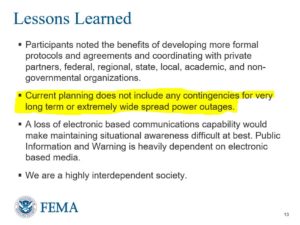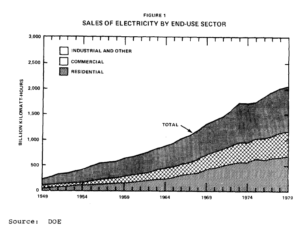Grid Physical Security – A Skeleton in the Government’s Closet

The Government Has Known for Almost 40 Years that Grid Physical Security and Preparedness for a Long-Term Power Outage is Inadequate
I have researched and written about the inadequacy of electric grid physical security for a while now. I have also summitted my findings on grid physical security to the Federal Energy Regulator Commission (FERC) and Congress. I have also researched and written about the inadequacy of our national preparedness for a long-term, large-scale blackout and sent numerous letters to the Federal Emergency Management Agency (FEMA). I even wrote a book on the subject - many copies of which I sent to FEMA, Congress and other government agencies at my own expense. The response? Crickets.
 Now, while updating the library of federal grid security documents, I have unearthed a General Accounting Office (Now known as the Government Accountability Office, or GAO) report from 1981 - almost 40 years ago - titled: "Federal Electrical Emergency Preparedness Is Inadequate."
Now, while updating the library of federal grid security documents, I have unearthed a General Accounting Office (Now known as the Government Accountability Office, or GAO) report from 1981 - almost 40 years ago - titled: "Federal Electrical Emergency Preparedness Is Inadequate."
This report is shocking.
If saboteurs, terrorists, or an enemy attacked the Nation's electric power system, would the Federal Government be prepared to handle the resulting energy disruptions?
Probably not, because the Department of Energy has failed to prepare required electric emergency preparedness plans. A national plan to cope with the problems caused by a loss of electricity--which would virtually halt communication, transportation, and distribution systems--is essential, because utilities and the States cannot be expected to deal with such emergencies on their own.
And that is just what is written on the cover of the report! Here is more of the GAO's findings from 1981:
The Federal Government is not now prepared to handle a long-term national or regional disruption in electric power, from an act of war, sabotage, or terrorism. Inadequate preparedness for such emergencies is not new. About 3 years ago, the Congress found that Federal programs dealing with electrical power emergencies were deficient.
The consequences of such a power outage are staggering. Electric power is essential to maintaining the Nation's military readiness. Without adequate or reliable power, most industrial activity would be disrupted. Power outages can disrupt the operation of computers, commercial business, water and sewage treatment plants, mass transit and traffic control systems, as well as many other aspects of life.
In the United States, electric power is generated by some 3,500 utility companies, sent over thousands of miles of high voltage transmission lines, and distributed over low voltage feeder lines to end users. The system is a highly complex, interconnected industry network covering the United States and parts of Canada.
Electric power systems are highly dependable, but are very vulnerable to disruptions from acts of war, sabotage, or terrorism. In the region GAO looked at:
- An attack on just eight substations could disrupt power to the entire region for a long time. (See p. 8.)
- Damage to just four substations could disrupt power to one city for up to a year. (Seep. 8.)
- Damage to just one substation could leave a key military facility without power. (See p. 8.)
What is shocking is that in 2019 the our electric grid physical security and the preparedness of our nation for a catastrophic power outage remains a complete mess.
Grid Physical Security Remains Inadequate (Or Non-Existent)
We now know that in 1981, the government was aware of the grid physical security vulnerabilities - and the catastrophic consequences of a long-term, wide-spread power outage.
By 2012, apparently little had been done. The National Academies published a report titled: Terrorism and the Electric Power Delivery System. The report discussed physical security of high-voltage transformers noting:
High-voltage transformers are of particular concern because they are vulnerable to attack, both from within and from outside the substation where they are located. These transformers are very large, difficult to move, custom-built, and difficult to replace. Most are no longer made in the United States, and the delivery time for new ones can run to months or years.
Then, on April 16, 2013, a major PG&E transformer substation in Metcalf California was attacked. The attack was well-planned and sophisticated. One year after the Metcalf attack, the Wall Street Journal ran two alarming stories:
Assault on California Power Station Raises Alarm on Potential for Terrorism. April Sniper Attack Knocked Out Substation, Raises Concern for Country’s Power Grid
Smith, Rebecca. Wall Street Journal. February 5, 2014
U.S. Risks National Blackout From Small-Scale Attack. Federal Analysis Says Sabotage of Nine Key Substations Is Sufficient for Broad Outage
Smith, Rebecca. Wall Street Journal. March 12, 2014
One would think that action would be taken. A lot of paper flew. After the February 5, 2014 Wall Street Journal article, the Senate sent a letter on February 7, 2014 to the Federal Energy Regulatory Commission (FERC), to ask them what they were doing to protect the grid. And FERC Responded telling the Senate that:
“Since the attack on the Metcalf facility in April 2013, the Commission’s staff has taken responsive action together with NERC, other federal and state agencies, and transmission and generation asset owners and operators.”
As a result of Metcalf, FERC ordered The North American Electric Reliability Corporation (NERC) to develop an electric grid physical security standard. Yes, that’s right—the industry is self-regulated and writes their own standards. Problem solved right?
Wrong.
As I have reported in detail HERE and HERE, the resulting grid physical security standard is 1) inadequate, and 2) does not appear to be actively enforced.
To me, it is unconscionable that after almost 40 years, the federal government has not gotten a handle on grid physical security.
The U.S. is Not Prepared for a Long-Term Power Outage.

As disturbing as it might be, despite the numerous threats to the U.S. electric grid, the federal government has no plan for a long-term power outage. FEMA recently admitted this at the National Preparedness Symposium on May 24, 2018:
"Current planning does not include any contingencies for very long term or extremely wide spread power outages." -FEMA
To FEMA's credit, they have the right idea in the first two goals of their strategic plan. We need to:
- Build a Culture of Preparedness
- Ready the Nation for Catastrophic Disasters
The problem is, very few at the local level view this as their primary mission. Everybody is waiting for FEMA to tell them what to do. And what have we heard from FEMA? Crickets.
In order to truly implement the first two points of their strategic plan, FEMA needs to:
- Clarify that emergency managers at all levels are responsible to build a culture of prepredness in their jurisdiction as a primary mission.
- Reinvigorate the old civil defense concepts of training the population. Using existing (and long neglected) programs like CERT and MRC will help - give them the community preparedness mission.
- Make grant funding available for local preparedness and civil defense activities (which plays right into strategic plan goal #3 - Reduce the Complexity of FEMA).
Unfortunately, without federal leadership, we will continue to "prepare for past disasters", fail to prepare for a worst case scenario and continue to be vulnerable as a nation. As GAO noted in 1981:
Because of the severe consequences of electric power disruptions, the Government must be concerned with the management and recovery of the Nation's power system during major emergencies resulting from war, sabotage, or terrorism. It is essential that electric emergency plans be developed beforehand so they can be quickly activated to allow officials to make difficult decisions in the midst of confusion. Once an electric emergency occurs, it will be too late to make preparations.

I have been lecturing on this topic not for several years - the title of my talk is "The Cavalry Is Not Coming." I have also written about how we became so vulnerable HERE and HERE.
The 1981 GAO report contains a great chart on how our dependence on electricity has increased between 1948 and 1979. (I wish this chart continued to 2019.) GAO notes: "Figure 1 shows that over the period 1949 to 1979 electric consumption increased by about 900 percent in the residential and commercial sectors and by about 500 percent in the industrial sector."
To me, it is unconscionable that after almost 40 years, the federal government has not gotten a handle on emergency preparedness for a long term, large scale blackout.
It's Worse Than They Thought in 1981
Finally, I should note that this disturbing 1981 GAO report was written before several modern threats to the electric grid were even recognized.
- In 1981 cybersecurity threats to the electric grid were largely unknown.
- In 1981 electromagnetic threats, such as an electromagnetic pulse (EMP) attack or a geomagnetic disturbance (GMD) were not as well understood as they are today.
- In 1981 climate change related threats to the critical infrastructure were not yet understood or considered.
So, what has GAO said since then? They have written 35 reports since then on the threats to the electric grid. The Congressional Research Service (CRS) has written 16 reports on the threats to the electric grid. The Congressional EMP Commission has published a series of most authoritative reports. You can find all of these reports in here in my library.
What should you do? Show this article to your federal and state representatives and ask them what they are doing to secure the grid. If you don't like the answer, be heard in the voting booth.
Ultimately, only citizens can hold the government accountable. Accountability for electric grid security is long overdue.
Related Articles:
- Physical Security: The Electric Grid’s Dirty Little Secret
- The Role of Transparency in Preventing Regulatory Failures
- Long-Term Power Outage: There Is No Plan
- FEMA: Let's Try Civil Defense
And if you are wondering why "they" don't fix grid physical security? Read these:
